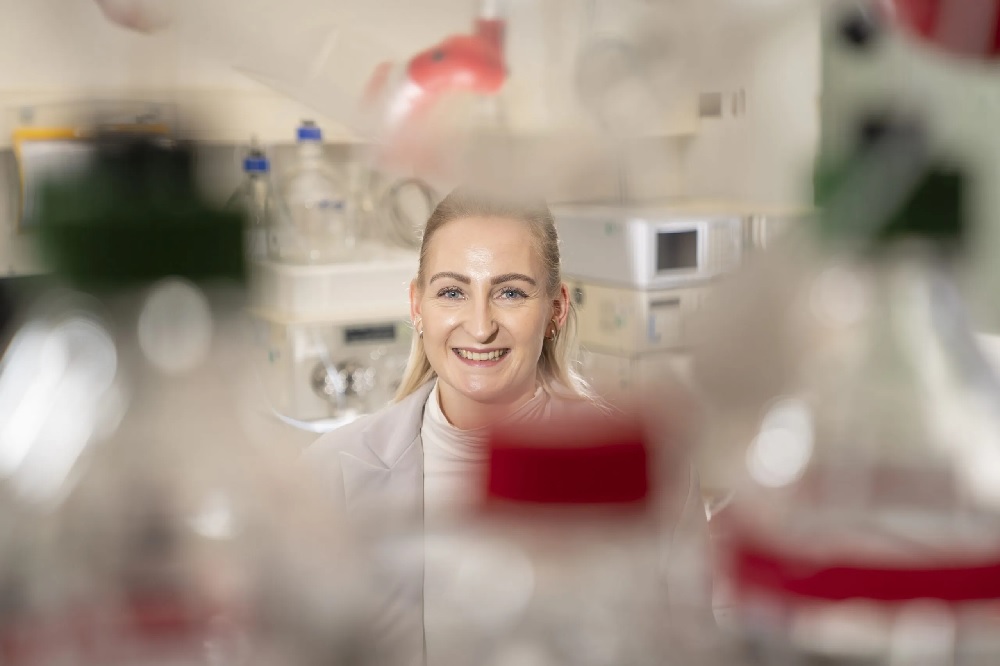Bodembacterie maakt eiwitten en geneesmiddelen van kooldioxide
Een bacterie die kan groeien op een mengsel van kooldioxide, zuurstof en waterstof is zo aan te passen dat hij nuttige stoffen produceert, zoals aminozuren, melkeiwitten of de bouwstenen voor geneesmiddelen. RUG biochemicus Sandy Schmidt wil deze bacterie voeden met de afvalgassen van fabrieken, zodat ze kooldioxide gaan omzetten in waardevolle moleculen.
De bodembacterie met de naam Cupriavidus necator, voor het eerst gevonden in de buurt van de Duitse stad Göttingen, was tot nu toe vooral beroemd omdat hij bioplastics kan maken. Sandy Schmidt, assistent hoogleraar bij het Groningen Research Institute of Pharmacy (GRIP) van de RUG wil dit micro-organisme op een andere manier gebruiken. ‘Hij groeit normaal gesproken op suiker, maar kan dat ook op een gasmengsel van kooldioxide, zuurstof en waterstof’, legt zij uit. ‘Mijn idee is om de bacterie te laten groeien op de afvalgassen van de chemische industrie of de staalindustrie, en te zorgen dat hij daar nuttige moleculen van gaat maken.’

Kaas
Door aan de stofwisseling van de bacterie te sleutelen is het mogelijk om hem bepaalde stoffen in grotere hoeveelheden te laten produceren, zoals bijvoorbeeld het aminozuur lysine, een belangrijke component in veevoer. ‘En we doen onderzoek voor een bedrijf dat veganistische kaas wil maken’, vertelt Schmidt. ‘Daarvoor moet de bacterie melkeiwitten produceren.’ Ze is er al in geslaagd om een bacterie melkeiwit te laten maken, maar voor het lysine project is eerst nog nieuwe genetisch gereedschap nodig. ‘Cupriavidus necator wordt niet echt veel gebruikt in de wetenschap, daarom zijn er maar weinig hulpmiddelen ontwikkeld om het genoom ervan aan te passen.’
Schmidt werkt inmiddels een jaar of twee aan deze projecten en ze verwacht de komende twee tot drie jaar de eerste tastbare resultaten te zien. ‘Dan moeten we stammen hebben die grote hoeveelheden produceren van de gewenste producten. De volgende stap is dan om de bacterie te kweken op industriële schaal, en dat kan nog eens vijf jaar duren.’ Behalve het opschalen is er nog een probleem: een mengsel van zuurstof en waterstof heet ook wel “knalgas”, het is nogal explosief. ‘Er loopt nu een onderzoek naar manieren om dit veilig te gebruiken.’
Afvalgassen
Als alles goed gaat zouden er bioreactoren kunnen komen te staan naast staalfabrieken zoals Tata Steel of chemische industrie, zoals BASF. Schmidt: ‘De afvalgassen van deze fabrieken bevatten ook zwavel of zware metalen, maar onze bacterie is behoorlijk ongevoelig voor deze vervuilende stoffen. We hoeven ze dus niet eerst te zuiveren voor gebruik.’

Geneesmiddelen
Er zit wel een bijzonder nadeel aan de superbacterie: hij stinkt ontzettend. ‘De lucht stoot studenten die er voor het eerst mee werken echt af.’ Maar verder lijkt Cupriavidus necator toch vooral een kip met gouden eieren. Behalve aminozuren en eiwitten kan hij ook bouwstenen voor geneesmiddelen maken, en stoffen die worden gelabeld met de koolstof-13 isotoop voor bij medische diagnostiek en MRI scans.
Schmidt kijkt ondertussen met belangstelling naar de ontwikkelingen rond FutureCarbonNL, een samenwerking van Nederlandse universiteiten waaronder de RUG, kennisinstituten, (chemische) industrie, het MKB en startups, die een miljoenenaanvraag heeft ingediend voor het Nationaal Groeifonds. Met dat geld zal onderzoek gefinancierd worden naar ‘carbon capture & utilization’, onderzoek naar manieren om koolstof af te vangen en nuttig te gebruiken. Wanneer deze aanvraag wordt toegekend hoopt Schmidt op extra financiering voor haar werk om kaas en geneesmiddelen te maken van fabrieksgas.
Meer nieuws
-
11 december 2025
Stormachtige planeten en een onverwachtse atmosfeer
-
09 december 2025
Faculty of Impact Grant voor nieuwe behandeling hersenkanker

